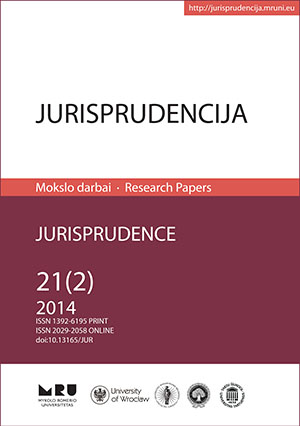Judicial Errors in Civil Proceedings: Concept, Causes and Procedural Methods of Their Prevention
Judicial Errors in Civil Proceedings: Concept, Causes and Procedural Methods of Their Prevention
Author(s): Nelia SavchynSubject(s): Law, Constitution, Jurisprudence
Published by: Mykolas Romeris University
Keywords: adjudication; causes; civil litigation; judge; judicial error; justice; occurrence; preventive methods
Summary/Abstract: This article defines the notion of judicial error, which is an unlawful (inaction) of the authorized entity (the judge), occurring regardless of his intention, outlined in a specific procedural document, that violates the procedural and (or) substantive laws, results in a failure to achieve the goals and carry out the duties of the procedural litigation, as a result of which a specific court ruling can be vitiated or modified either by a higher court or by the issued court (correction of typographical and arithmetic errors, additional ruling, judgement clarification). There are no occurrences or events in the world that would not have a cause for their emergence or existence. A judicial error also has defined reasons of its emergence and existence. The analysis of causes of judicial errors has an important practical meaning as it allows creating methods of organisational, legal and procedural character for elimination and prevention of judicial errors. Identifying the causes of judicial errors is useful not only for elimination of judicial errors, but also for prevention of their occurrence. The causes of judicial errors include the following: 1) inadequate level of education and training of judges; 2) lack of appropriate moral qualities of judges; 3) lack of knowledge of substantive and procedural law; 4) dishonesty, superficial, careless and formal attitude of judges towards their duties; 5) inability to organize their work correctly; 6) careless filing of procedural documents; 7) absence of job experience; 8) ignorance of higher court clarifications on the application of state law; 9) subjective views, likes and dislikes of judges; 10) low level of judges’ discipline; 11) the bias of the court; 12) violation of statutory procedural terms, etc. Removing judicial errors through vitiation and modification of the ruling is an undesired extreme measure as an act of justice and it should not be viewed as a standard occurrence (in terms of legal regulation), but rather as an exceptional one. Thus, it is evident that in order to increase the effectiveness of civil litigation, preventive methods should be considered equally important to the elimination methods of judicial errors. Procedural methods of judicial errors prevention in civil litigation are specific provisions of the Civil Procedure Law, the execution of which significantly hurdles the occurrence of judicial errors in civil proceedings. One of the most effective methods of increasing the effectiveness of justice system in civil proceedings includes the following: – the right to recast judges; – consideration of cases by a panel of judges; – rendering a ruling in the jury room; – institutional structure of the court system; – the concept of direct court investigation; – transparency and openness of the justice system; – compilations of judicial practice by higher courts.
Journal: Jurisprudencija
- Issue Year: 21/2014
- Issue No: 2
- Page Range: 484–505
- Page Count: 22
- Language: English

